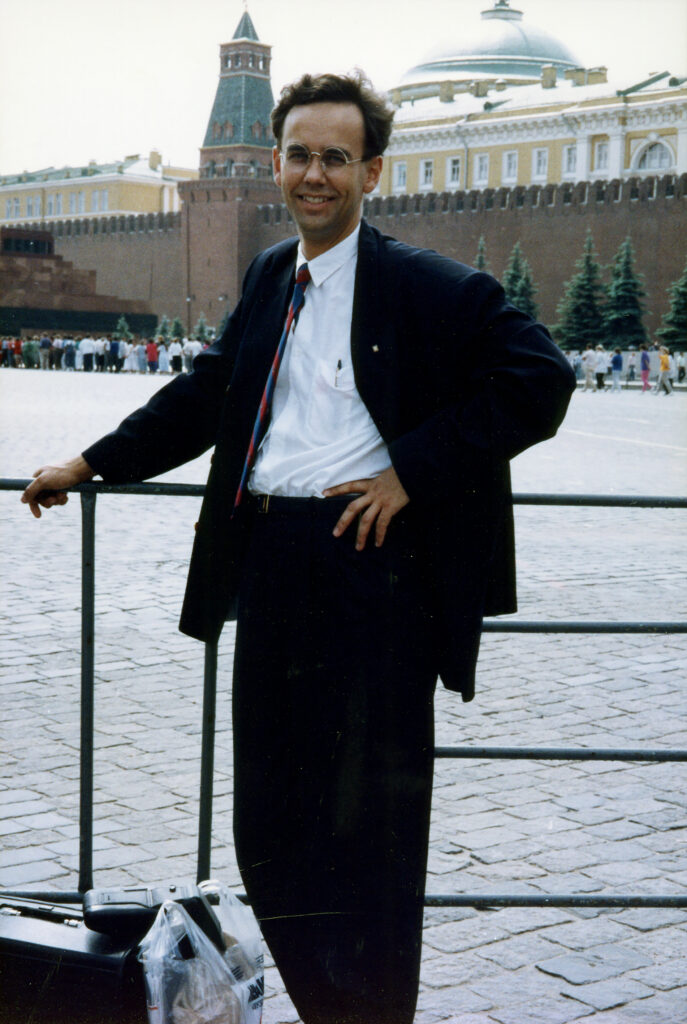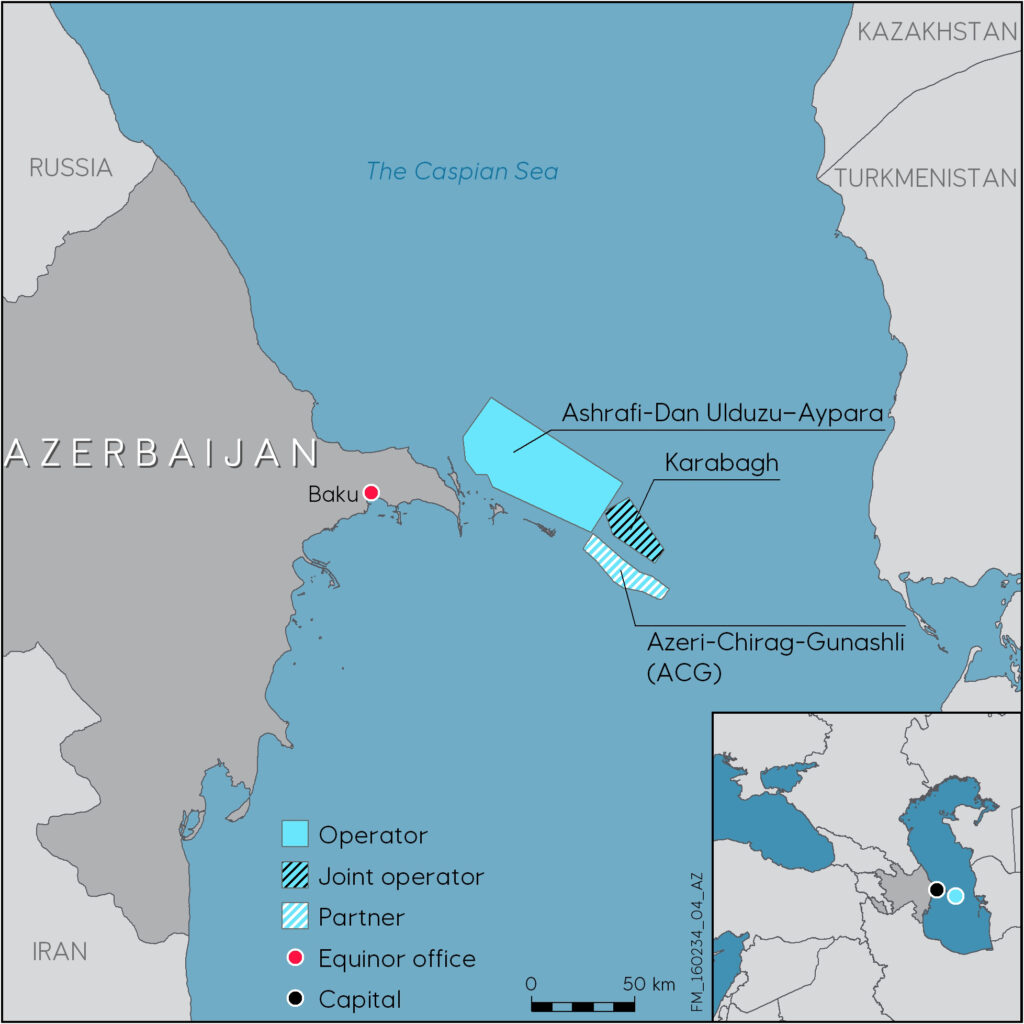Making good in the Caspian

Famed Norwegian author Knut Hamsun described a suburb of Baku, Azerbaijan’s capital, during a visit in 1899 as a black town undermined by pipes flowing with oil, where trams crossed small oily pools oozing from the ground and gleaming with the finest metallic colours. “It smells worse here than in Baku,” he added.
In the early 1990s, creaking could still be heard from the numerous rusty old pumpjacks (nodding donkeys) which covered the desert landscape. A sharp smell of oil tore at the nostrils.
A new chapter in the country’s oil history opened in 1991 out in the Caspian. Western oil companies lined up to invest billions of dollars in this Caucasian country.
They included Statoil, which established itself in Azerbaijan during 1991 with BP. The two companies had forged an alliance earlier that year on exploring for and producing oil and gas. The partnership’s strategic plans were characterised by the optimism which prevailed in oil circles during the early 1990s about newly opened areas. Parts of the former USSR clearly topped the wish list.
The great upheavals in eastern Europe in 1989 and the consequent Soviet collapse opened the way to foreign investment. And the big oil companies flocked to the giant country in the east, with some concentrating on the massive wealth of Siberia.
By contrast, the Statoil-BP alliance’s attention was fixed on Azerbaijan’s sector of the Caspian. This was defined as “the greatest upstream opportunity in recent times” in the strategy document drawn up for the alliance in 1991.
The big Azeri-Chirag field out in the inland sea was of particular interest. It had been proven in Soviet times, but the USSR lacked both the technology and the capital to bring this discovery on stream.
Contract of the century

In 1991, the BP/Statoil alliance secured a letter of intent covering Azeri-Chirag from the oil ministry in Baku. It was obtained during a very turbulent period in Azerbaijan’s political life.
Violent clashes had developed in 1990 between Armenians and Azeris over large parts of Azerbaijan because of a conflict in the autonomous province of Nagorno-Karabakh. A state of emergency was declared in Baku and other towns. The strife claimed more than 30 000 lives, and several hundred thousand people became internally displaced before a ceasefire was brokered in 1994.
Heydar Aliyev, a former high-ranking KGB officer and chair of the Supreme Soviet in Azerbaijan until he was dismissed in 1987, was elected president of the young republic in 1993. He helped to establish order and political stability, but also led a shift towards a more authoritarian form of government. Aliyev cancelled the letter of intent with BP/Statoil in favour of a new agreement with US oil company Amoco.
A contest developed over interests in Azeri-Chirag, with both access to the oil and control over future pipelines in dispute. The agreement with Amoco was cancelled in its turn and the government sought bids from more international companies.
On 20 September 1994, Azerbaijan signed a new deal with 11 western oil companies on developing and operating Azeri-Chirag as well as the neighbouring Gunashli field. Statoil secured an 8.6 per cent share in this ACG production sharing agreement (PSA), while BP obtained double that stake in line with the partnership’s predetermined sharing formula. Subsequently described by Equinor as “the contract of the century”, the ACG PSA was extended in 2017 for a further 25 years until the end of 2049.[REMOVE]Fotnote: Equinor webpage
Statoil was thereby involved in developing and producing oil in one of the world’s most authoritarian and corrupt countries.

The agreement included a “signature bonus” – an “advance tax” or remuneration paid by companies to secure rights. Such bonuses are a common form of money transfer in corrupt, undemocratic countries and have been described as “a legal form of corruption”.
Azerbaijan’s substantial oil and gas resources fuelled fantastic economic growth and wealth – with corruption and an oppressive dictatorship as part of the price. Arenas for opposition, activism and investigative journalism have been steadily curtailed since the 1990s. The threshold for arrest, unjust legal processes and long prison sentences for regime critics is low. But the big oil revenues have made it possible to operate very successfully in geopolitical terms and to silence criticism of the comprehensive human rights breaches.[REMOVE]Fotnote: https://www.nhc.no/en/azerbaijan/

Operatorship
The BP/Statoil alliance expanded its involvement in Azerbaijan during 1996, when each company acquired 25 per cent of the promising Shah Deniz discovery. This proved to be the biggest gas field in the country and one of the world’s largest offshore.

BP became operator for the field, with Statoil responsible for selling the gas. The agreement also embraced the South Caucasus Pipeline (SCP) to markets in Turkey, Azerbaijan and Georgia.
Statoil additionally secured an 8.7 per cent holding in the Baku-Tbilisi-Ceyhan (BTC) pipeline for exporting ACG oil. This runs from the Azerbaijan capital to Mediterranean port of Ceyhan in southern Turkey.
In recent times, the company has conducted several farm-ins/outs, and the ownership structure has changed. When the first drilling rig reached Shah Deniz, the alliance with BP had been dissolved. Statoil then established its own office in Baku and retained the holdings it had received in the various fields.
Negotiations were pursued with the aim of securing operatorships in Azerbaijan, with support from the highest political quarters in Norway. Where the Azeris were concerned, top-level talks between the foreign ministers of the two countries strengthened their legitimacy.
Azeri-Chirag-Gunashli (ACG) is the largest oil field in Azerbaijan’s sector of the Caspian. It lies in 125-180 metres of water, about 100 kilometres east of Baku. Development has been based on fixed platforms and technology for subsea injection. The latest estimate from BP puts total recoverable reserves in ACG at about three billion barrels over the 2018-49 life of the PSA. Crude oil from the field is piped for pre-export processing to the Sangachal terminal, a hub with a daily capacity of 1.2 million barrels.
Recent developments
Equinor and the State Oil Company of the Azerbaijan Republic (Socar) signed a risk service agreement (RSA) on 30 May 2018 related to assessment and development of the Karabagh oil field, located 120 kilometres east of Baku.
Work on drilling the KPS-4 appraisal well in about 180 metres of water was initiated by Equinor as operator in December 2019. It and Socar confirmed the discovery of oil in this prospect during March 2020. The two companies established the Karabakh Joint Operating Company (KJOC) as a 50-50 joint venture.
Equinor later secured access to the Ashrafi-Dan-Ulduzu-Aypara (Adua) exploration area in the Caspian. A PSA was signed with Socar in May 2018, giving the two parties equal stakes. Adua lies about 100-110 kilometres north-east of Baku, and Equinor conducted two- and three-dimensional seismic surveying in the prospective area during 2019.
Its presence in Azerbaijan is one of Statoil/Equinor’s largest and longest international commitments and, alongside BP, the company ranks among the biggest international investors in the country. This long-term engagement has been financially rewarding for both company and country.
arrow_backStatfjord satellites with fruitful industrial collaborationSleipner A GBS – lost and replacedarrow_forward